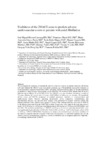Mostrar o rexistro simple do ítem
Usefulness of the 2MACE score to predicts adverse cardiovascular events in patients with atrial fibrillation
| dc.contributor.author | Rivera-Caravaca, José Miguel | |
| dc.contributor.author | Marín, Francisco | |
| dc.contributor.author | Esteve-Pastor, María Asunción | |
| dc.contributor.author | Raña-Míguez, Paula | |
| dc.contributor.author | Anguita, Manuel | |
| dc.contributor.author | Muñiz, Javier | |
| dc.contributor.author | Cequier, Ángel | |
| dc.contributor.author | Bertomeu-Martínez, Vicente | |
| dc.contributor.author | Valdés, Mariano | |
| dc.contributor.author | Vicente, Vicente | |
| dc.contributor.author | Lip, Gregory | |
| dc.contributor.author | Roldán, Vanessa | |
| dc.date.accessioned | 2017-11-23T11:26:54Z | |
| dc.date.issued | 2017-09-19 | |
| dc.identifier.citation | Rivera-Caravaca JM, Marín F, Esteve-Pastor MA, et al. Usefulness of the 2MACE score to predicts adverse cardiovascular events in patients with atrial fibrillation. L Am Cardiol. 2017;120(12): 2176-2181 | es_ES |
| dc.identifier.issn | 0002-9149 | |
| dc.identifier.uri | http://hdl.handle.net/2183/19812 | |
| dc.description.abstract | [Abstract] We investigated the incidence of nonembolic adverse events in 2 cohorts of patients with atrial fibrillation (AF) and validated the 2MACE score ([metabolic syndrome, age ≥75] [doubled]; [myocardial infarction or revascularization, congestive heart failure {HF}, and stroke, transient ischemic attack or thromboembolism]) as predictor of major adverse cardiovascular events (MACEs). We recruited 2,630 patients with AF from 2 different cohorts (Murcia AF and FANTASIIA). The 2MACE score was calculated, and during a median of 7.2 years (Murcia AF cohort) and 1.01 years (FANTASIIA) of follow-up, we recorded all nonembolic adverse events and MACEs (composite of nonfatal myocardial infarction or revascularization and cardiovascular death). Receiver operating characteristic curves comparison, reclassification and discriminatory analyses, and decision curve analyses were performed to compare predictive ability and clinical usefulness of the 2MACE score against CHA2DS2-VASc. During follow-up, there were 65 MACEs in the Murcia cohort and 60 in the FANTASIIA cohort. Events rates were higher in the high-risk category (score ≥3) (1.94%/year vs 0.81%/year in the Murcia cohort; 6.01%/year vs 1.71%/year, in FANTASIIA, both p <0.001). The predictive performance of 2MACE according to the receiver operating characteristic curve was significantly higher than that of CHA2DS2-VASc (0.662 vs 0.618, p = 0.008 in the Murcia cohort; 0.656 vs 0.565, p = 0.003 in FANTASIIA). Decision curve analyses demonstrated improved clinical usefulness of the 2MACE compared with the CHA2DS2-VASc score. In conclusion, in “real-world” patients with AF, the 2MACE score is a good predictor of MACEs. A score ≥3 should be used to categorize patients at “high risk,” in identifying patients at risk of MACE. | es_ES |
| dc.description.sponsorship | Instituto de Salud Carlos III; PI13/00513 | es_ES |
| dc.description.sponsorship | Instituto de Salud Carlos III; P14/00253 | es_ES |
| dc.description.sponsorship | Fundación Séneca; 19245/PI/14 | es_ES |
| dc.description.sponsorship | Instituto Murciano de Investigación Biosanitaria; IMIB16/AP/01/06 | es_ES |
| dc.language.iso | eng | es_ES |
| dc.publisher | Elsevier | es_ES |
| dc.relation.uri | http://dx.doi.org/10.1016/j.amjcard.2017.09.003 | es_ES |
| dc.rights | Atribución-NoComercial-SinDerivadas 3.0 España | es_ES |
| dc.rights.uri | http://creativecommons.org/licenses/by-nc-nd/3.0/es/ | * |
| dc.title | Usefulness of the 2MACE score to predicts adverse cardiovascular events in patients with atrial fibrillation | es_ES |
| dc.type | info:eu-repo/semantics/article | es_ES |
| dc.rights.access | info:eu-repo/semantics/embargoedAccess | es_ES |
| dc.date.embargoEndDate | 2018-09-19 | es_ES |
| dc.date.embargoLift | 2018-09-19 | |
| UDC.journalTitle | The American Journal of Cardiology | es_ES |
| UDC.volume | 120 | es_ES |
| UDC.issue | 12 | es_ES |
| UDC.startPage | 2176 | es_ES |
| UDC.endPage | 2181 | es_ES |
Ficheiros no ítem
Este ítem aparece na(s) seguinte(s) colección(s)
-
INIBIC-ECAPE - Artigos [31]
-
GI- GRINCAR - Artigos [203]






